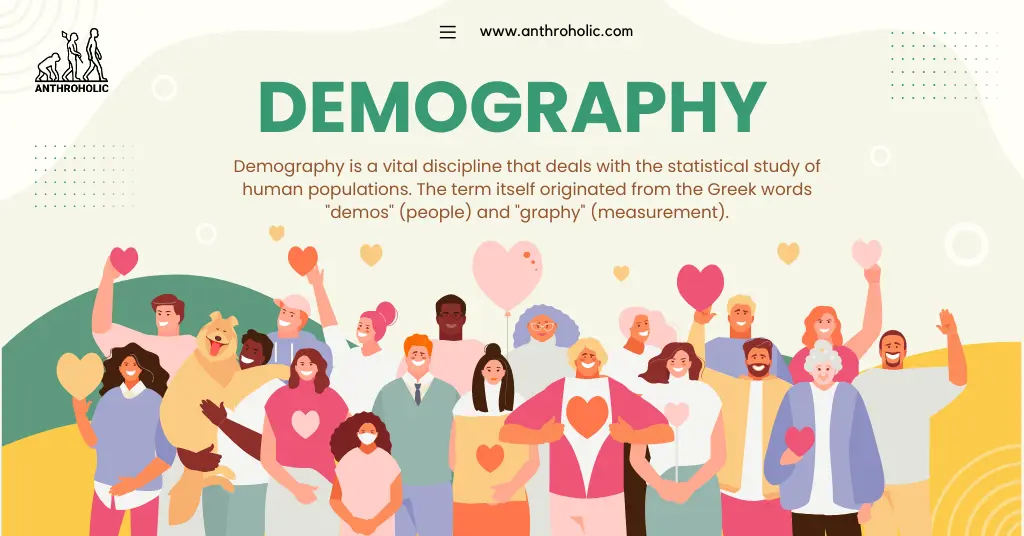AI Answer Evaluation Platform Live Now. Try Free Answer Evaluation Now
Demography
Demography is a vital discipline that deals with the statistical study of human populations. The term itself originated from the Greek words “demos” (people) and “graphy” (measurement). This multifaceted field is essential for developing effective public policies and understanding societal changes over time.

The Scope of Demography
Demography encompasses various elements, including:
- Population size and distribution
- Population density
- Birth rates, death rates, and migration rates
- Age and sex structure
- Socioeconomic and racial composition
The study of these aspects helps demographers gain insights into crucial patterns and trends in a population [1].
Components of Population Change
Birth Rates
The birth rate is typically expressed as the number of live births per 1,000 population in a year. It’s an essential factor contributing to population growth.
Death Rates
The death (mortality) rate represents the number of deaths per 1,000 population within a year. It helps identify trends in life expectancy and mortality risks.
Migration
Migration affects population size and distribution. It refers to the movement of people from one geographical location to another. Migration can be internal (within the country) or external (to a different country).
Age and Sex Structure
The age and sex structure of a population, often depicted using population pyramids, illustrates the distribution of different age groups and genders. This information is critical for planning social services such as education and healthcare.
Demographic Transition Model
The Demographic Transition Model (DTM) is a tool that demographers use to understand the progression of a society from high birth and death rates to low birth and death rates, typically accompanying economic development. It comprises four stages:
- High birth and death rates (pre-industrial society)
- Declining death rates, high birth rates (early industrial society)
- Declining birth rates, low death rates (late industrial society)
- Low birth and death rates (post-industrial society)
Understanding these stages can provide insights into population dynamics and societal growth patterns [2].
| Stage | Birth Rate | Death Rate | Society |
|---|---|---|---|
| 1 | High | High | Pre-industrial |
| 2 | High | Declining | Early Industrial |
| 3 | Declining | Low | Late Industrial |
| 4 | Low | Low | Post-Industrial |
Applications of Demography
Demography has broad implications and applications, such as:
- Policy-making: Governments utilize demographic data to create policies that address population needs. These can range from health, education, housing, and social security policies [3].
- Market Research: Businesses use demographic data to identify target customers and market trends.
- Urban Planning: City planners utilize demographic data to design infrastructure that meets the current and future needs of the population.
- Healthcare Planning: Demographic data assists in predicting disease trends and planning healthcare services accordingly.
Challenges in Demography
Demography is not without its challenges. Key issues include:
- Data Accuracy: The quality and reliability of demographic data can vary, affecting the accuracy of analyses and forecasts [4].
- Political Influences: Political factors can influence demographic studies, especially regarding census data collection and interpretation.
- Climate Change: Climate change and environmental issues bring a new layer of complexity to demographic studies.
The Importance of Demographic Data in Decision Making
Demographic data are crucial in decision making across various sectors. They assist in determining the distribution of resources, setting health and educational policies, and tailoring products or services to a specific population segment. Here’s a closer look at the practical implications of demographic data:
- Resource Allocation: Governments use demographic data to ensure fair and efficient allocation of resources. Such data helps identify areas with high population densities that may need more resources like schools, hospitals, or public transportation [5].
- Policy Development: Policymakers use demographic data to create strategies for handling issues such as aging populations, low fertility rates, or high migration rates. Such data is essential for formulating and implementing effective policies [6].
- Market Segmentation: Businesses use demographic data to segment their market and tailor their products or services to meet the specific needs of different population groups. For instance, a business targeting young adults may use demographic data to understand their preferences and tailor marketing strategies accordingly [7].
- Infrastructure Planning: Demographic data are invaluable in planning for infrastructure development. City planners use these data to understand population trends and ensure that infrastructure growth aligns with population growth and changes.
Technological Advancements in Demography
Technological advancements have revolutionized demography, allowing for more accurate data collection and analysis:
- Big Data and Machine Learning: The rise of big data has enabled the collection of large-scale demographic data, while machine learning allows for sophisticated pattern recognition within this data. These technologies enable more accurate population predictions [8].
- Geographic Information Systems (GIS): GIS technology has revolutionized demographic data visualization. It allows demographers to map and analyze the geographical distribution of different population characteristics.
- Digital Surveys: Online and mobile-based surveys have made data collection more efficient and have increased the reach of demographic studies [9].
Future of Demography
The future of demography lies in its ability to adapt and incorporate emerging trends and technologies:
- Increased Use of Big Data: The use of big data in demography will continue to rise. This will improve the quality and granularity of demographic data, leading to more accurate analyses and forecasts.
- Integration with Other Disciplines: Demography will increasingly be integrated with other fields such as economics, sociology, and public health to provide a more holistic view of population trends.
- Addressing Global Challenges: Demographers will play a crucial role in addressing global challenges, such as climate change, urbanization, and migration, by providing valuable insights into population trends and patterns.
Conclusion
In a world that’s continuously changing, demography provides crucial insights into population dynamics. It’s a key tool in societal planning and decision-making at various levels. Despite the challenges, the field continues to evolve, incorporating new methodologies and technologies to better understand and predict population trends.
References
[1] Weeks, J. R. (2015). Population: An Introduction to Concepts and Issues.
[2] Notestein, F. W. (1945). Population – The Long View. In Food for the World, Schultz, T. W. (Ed.).
[3] Kertzer, D. I., & Hogan, D. P. (1989). Family, political economy, and demographic change.
[4] Hirschman, C., Preston, S., & Loi, V. M. (1995). Methods and substance in macrocomparative demography.
[5] Coleman, D. (2013). The Demographic Foundations of the Information Society. Population and Development Review.
[6] United Nations, Department of Economic and Social Affairs, Population Division (2015). World Population Ageing.
[7] Kotler, P., & Armstrong, G. (2010). Principles of Marketing. Pearson Education.
[8] Raftery, A. E., Li, N., Ševčíková, H., Gerland, P., & Heilig, G. K. (2012). Bayesian probabilistic population projections for all countries. Proceedings of the National Academy of Sciences.
[9] Couper, M. P. (2017). New Developments in Survey Data Collection. Annual Review of Sociology.




